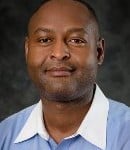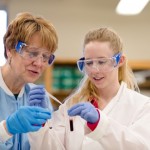
Kambrie Boomgaard (Grand Rapids Community College) will be presenting a poster based on research in Dr. Ebenezer Tumban’s research lab.
Her title and abstract are:
Assessing the Solubility of Recombinant Bacteriophage L2 Coat Proteins in Two Bacterial Strains
Kambrie Boomgaard1,, Lukai Zhai2, Ebenezer Tumban2
1Grand Rapids Community College, 2Department of Biological Sciences, Michigan Technological University
Abstract:
Currently, there are about 19 human papillomavirus (HPV) types that can cause cervical, penile, and anal cancers. A Second-generation HPV vaccine (Gardasil-9) has been approved to protect against more HPV types. However, the vaccine is going to protect against HPV types that cause only 86-90% of HPV-associated cervical and penile cancers. Complete protection from all HPV-associated cancers requires the addition of HPV L1 capsid from all cancer-causing HPVs. As an alternative approach to L1, we targeted conserved epitopes on L2 capsid protein to elicit broad protection against more HPV types. We developed bacteriophage (phage) MS2 and AP205 virus-like particles (VLPs) displaying a conserved L2 epitope and consensus epitopes from the L2 of all cancer-causing HPV types. Although some of the L2-phage coat proteins assembled efficiently into VLPs, the assembly of other L2-phage coat proteins were sub-optimal. The main goal of this research was to assess if the solubility and assembly of the sub-optimal L2-phage coat proteins could be enhanced by expressing the proteins in two different bacterial strains and at different temperatures. Our preliminary results show that AP205 displaying L2 is expressed and is soluble in Origami cells induced at 37 °C.
MiCUP Poster Presentation
by Center for Diversity and Inclusion
Join the Center for Diversity and Inclusion from 3 to 5 p.m. Thursday June 16, in MUB Ballroom A where students from Delta College, Grand Rapids Community College and Wayne County Community College who have been participating theMiCUP Residential Summer Research Program will present posters.
Join in a celebration of their accomplishments. This event is free and open to the public. Refreshments will be served.

